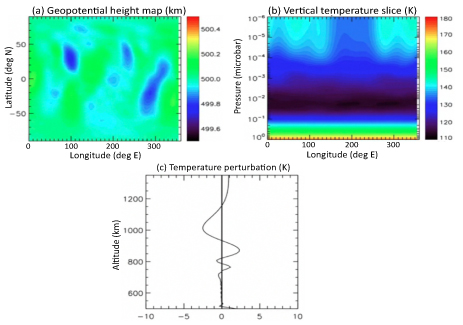2013 Annual Science Report
 NASA Jet Propulsion Laboratory - Titan
Reporting | SEP 2012 – AUG 2013
NASA Jet Propulsion Laboratory - Titan
Reporting | SEP 2012 – AUG 2013
Task 2.1.2.1: Titan General Circulation Model
Project Summary
The goal of this effort is to produce realistic Titan atmospheric profiles [winds, temperatures and densities] from the surface to ~1200km, for a variety of seasons and solar cycles, for use by members of the overall Titan NAI project.
Project Progress
In the last year we have extracted 3D data from the TitanWRF General Circulation Model (GCM) of Co-I Newman (extending from the surface to ~400km; Newman et al. [2011]) and from the Titan Thermospheric GCM (TGCM) of Collaborator Müller-Wodarg (covering ~600km to ~1200km; Müller-Wodarg et al. [2003, 2008]) for several seasons. These data have been provided to Titan NAI Co-I Yuk Yung and his team, who have used these 3D datasets to provide 2D (latitude-height) streamfunctions, interpolating across the gap from ~400-600km. The resulting streamfunctions have then been used as input to the 2D Caltech/JPL KINETICS model, which is being used to understand the seasonal and meridional distribution of hydrocarbons as well as other atmospheric cycles on Titan.
The above method is not optimal, in part because the lower atmosphere is expected to have significant impact on the upper atmosphere flow. In other words, the TGCM results produced by a standalone model are likely very different to those that would have been produced if the TGCM atmosphere had ‘sat above’ the atmosphere simulated by TitanWRF. Over the last year we have therefore also begun to couple TitanWRF and the TGCM. For a given season of the Titan year in long-term ‘spun up’ TitanWRF simulations [as in e.g. Newman et al., 2011], we extracted winds, temperatures and geopotential height on pressure surfaces just below the top of the TitanWRF domain (~350-400km). We then used these fields as the time-varying lower boundary conditions for the TGCM. This required us to first extend the lower boundary of the TGCM down below 400km to provide overlap with TitanWRF. The TGCM’s radiative transfer scheme was not updated to include the pressure broadening that becomes important over the 400-600km region, which likely resulted in less accurate simulation of this region. However, in a dynamical sense this enabled the TGCM’s lower boundary to be forced with seasonally-realistic zonal winds and to be perturbed by waves propagating up from the lower atmosphere, rather than imposing a smooth lower boundary condition, e.g. with a uniform zonal wind speed. Figure 1 shows (a.) a snapshot of the geopotential height field at the 3 microbar pressure level used to define the boundary between the two GCMs, and the TGCM’s response to the TitanWRF forcing in the form of (b.) significant wave activity at lower pressures and (c.) temperature perturbations, which appear promising because the vertical wavelength and magnitude of the perturbations are of the same order as seen in observed temperatures. Work is ongoing, but data from these coupled simulations will be provided to Yuk Yung and team in due course.

Publications
-
Müller-Wodarg, I. C. F. (2003). On the global distribution of neutral gases in Titan’s upper atmosphere and its effect on the thermal structure. Journal of Geophysical Research, 108(A12), None. doi:10.1029/2003ja010054
-
Müller-Wodarg, I. C. F., Yelle, R. V., Cui, J., & Waite, J. H. (2008). Horizontal structures and dynamics of Titan’s thermosphere. Journal of Geophysical Research, 113(E10), None. doi:10.1029/2007je003033
-
Newman, C. E., Lee, C., Lian, Y., Richardson, M. I., & Toigo, A. D. (2011). Stratospheric superrotation in the TitanWRF model. Icarus, 213(2), 636–654. doi:10.1016/j.icarus.2011.03.025
-
PROJECT INVESTIGATORS:
-
PROJECT MEMBERS:
Claire Newman
Co-Investigator
Ingo Mueller-Wodarg
Collaborator
-
RELATED OBJECTIVES:
Objective 2.2
Outer Solar System exploration